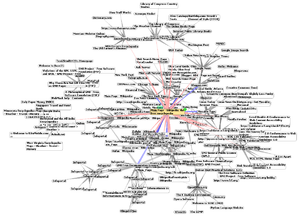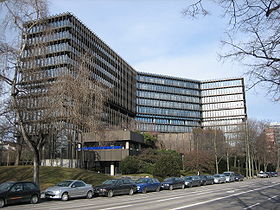
Internet as a source of prior art
Encyclopedia

Novelty (patent)
Novelty is a patentability requirement. An invention is not patentable if the claimed subject matter was disclosed before the date of filing, or before the date of priority if a priority is claimed, of the patent application....
and inventive
Inventive step and non-obviousness
The inventive step and non-obviousness reflect a same general patentability requirement present in most patent laws, according to which an invention should be sufficiently inventive — i.e., non-obvious — in order to be patented....
, is problematic since it is often difficult to ascertain precisely when information on websites became available to the public. Case law
Case law
In law, case law is the set of reported judicial decisions of selected appellate courts and other courts of first instance which make new interpretations of the law and, therefore, can be cited as precedents in a process known as stare decisis...
relating to the evidentiary
Evidence (law)
The law of evidence encompasses the rules and legal principles that govern the proof of facts in a legal proceeding. These rules determine what evidence can be considered by the trier of fact in reaching its decision and, sometimes, the weight that may be given to that evidence...
value of information retrieved from the Internet is sparse but concludes that using the Internet is acceptable provided that the date of a particular disclosure can be reliably determined.
Background
In most patent laws, an (alleged) invention has to be "newNovelty (patent)
Novelty is a patentability requirement. An invention is not patentable if the claimed subject matter was disclosed before the date of filing, or before the date of priority if a priority is claimed, of the patent application....
" and "inventive" (or non-obvious, which is basically synonymous of "inventive") to be considered "patentable", i.e. to be validly patented. An invention is considered to be new if it does not form part of the "prior art
Prior art
Prior art , in most systems of patent law, constitutes all information that has been made available to the public in any form before a given date that might be relevant to a patent's claims of originality...
" (or state of the art), i.e. if it was not already disclosed in the prior art. An invention is considered to be inventive if it is not obvious in view of the prior art. The prior art is essentially everything which was made available to the public before the filing date of the patent.
In practice, if a device or a method was already known (e.g. described in a scientific paper) before the filing date of the patent covering the device or the method or if the device or method is obvious in view of what was known before the filing date, then, in general, it is not considered to be new (because known before the filing date) or not considered to be inventive (because obvious in view of what was known before the filing date of the patent), and then not considered "patentable". A patent cannot be obtained for the device or method, or, if obtained ("granted"), it can generally be "invalidated".
The identification of the prior art is therefore of utmost importance to determine whether an invention is patentable, i.e. whether a patent can be granted for an invention (or whether a patent which has been granted for an invention is valid). The purpose of the novelty criterion is to prevent the prior art being patented again.
The Internet is a popular source of technical information and is of particular interest for the purposes of establishing the prior art. Its use is however surrounded by concerns as to its reliability.
European Patent Organisation

European Patent Office
The European Patent Office is one of the two organs of the European Patent Organisation , the other being the Administrative Council. The EPO acts as executive body for the Organisation while the Administrative Council acts as its supervisory body as well as, to a limited extent, its legislative...
(EPO) in decision T 1134/06 considered that
- "there are recognized reliability and security issues concerning the Internet and the web and information retrieved from them. (...) It is thus at the present state of affairs often very difficult to establish with a high degree of reliability what exactly appeared on a web site and when."
In particular, the Board considered the evidentiary value of information from web page
Web page
A web page or webpage is a document or information resource that is suitable for the World Wide Web and can be accessed through a web browser and displayed on a monitor or mobile device. This information is usually in HTML or XHTML format, and may provide navigation to other web pages via hypertext...
s retrieved on the Internet Archive
Internet Archive
The Internet Archive is a non-profit digital library with the stated mission of "universal access to all knowledge". It offers permanent storage and access to collections of digitized materials, including websites, music, moving images, and nearly 3 million public domain books. The Internet Archive...
. The Board found that previous case law decisions did not find that the information retrieved from the Internet was excluded per se.
- "A disclosure on the Internet may be comprised within the state of the art... If an Internet disclosure is to be used as prior art a strict standard of proof should be adopted. Thus, the fact that an Internet disclosure is state of the art ... should be proved "beyond any reasonable doubt". The particular facts and evidence required will depend on each individual case, but will normally have to ... answer the questions of when the Internet disclosure was made available to the public, what was made available and under which circumstances was it made available to the public. Concerning the latter question, it will in most cases be necessary to address the main concern of reliability surrounding the Internet, in particular so as to establish whether and in how far a retrieved disclosure is true to the disclosure appearing at that date."
Regarding the Internet Archive, the Board finally held that
- "Where a disclosure has been retrieved from [such a resource], further evidence concerning the history of the disclosure, whether and how it has been modified since the date it originally appeared on a web site will be necessary. This could be in the form of an authoritative statement from the archivistArchivistAn archivist is a professional who assesses, collects, organizes, preserves, maintains control over, and provides access to information determined to have long-term value. The information maintained by an archivist can be any form of media...
. Alternatively, an appropriate statement as to the content, either from the owner or author of the archived web site which included the disclosure may suffice."
According to David Rogers, Legal Member of a Board of Appeal at the EPO, "practitioners
Patent attorney
A patent attorney is an attorney who has the specialized qualifications necessary for representing clients in obtaining patents and acting in all matters and procedures relating to patent law and practice, such as filing an opposition...
who are looking for ‘killer’ prior art would be well advised to stick with the traditional print means, unless they have a considerable body of evidence to support the reliability of an internet disclosure. The case also sets out how a party can cast doubt on the reliability of such disclosures."
Meanwhile, in August 2009, the EPO published a "notice concerning internet citations" to "[set] out the practice followed at the EPO when citing documents retrieved from the internet in both the European and the PCT procedure." The notice is not binding on the Boards of Appeal. Regarding the standard of proof, the notice reads:
- "When an internet document is cited against an application or patent, the same facts are to be established as for any other piece of evidence, including standard paper publications ... This evaluation is made according to the principle of "free evaluation of evidence" ... That means that each piece of evidence is given an appropriate weighting according to its probative value which is evaluated in view of the particular circumstances of each case. For assessing these circumstances, the balance of probabilities will be used as the standard of proof, as generally applied by the boards of appeal. According to this standard, it is not sufficient that the alleged fact (e.g. the publication date) is merely probable; the examining division must be convinced that it is correct. It does mean, however, that proof beyond reasonable doubt ("up to the hilt") of the alleged fact is not required."
Germany
In 2002, "the BundespatentgerichtBundespatentgericht
The Bundespatentgericht , or German Federal Patent Court, is a German federal court competent for particular legal matters, such as patent and trademark cases. It has its seat in Munich, Germany.- External links :...
in case BPatG 17W (pat) 1/02 (see GRUR
Gewerblicher Rechtsschutz und Urheberrecht
Gewerblicher Rechtsschutz und Urheberrecht is a monthly intellectual property law journal published in German. It is the journal of the German Association for the Protection of Intellectual Property and was established in 1899. The journal articles mainly concern German law...
2003 Heft 04, pp 323-325) confirmed in later BPatG 17W (pat) 47/00, ruled that the Internet was not a reliable source for determining the state of the art. This applied also to web archives such as the Internet
Archive."
United States
Internet publications can be relied on as prior art under United States patent lawUnited States patent law
United States patent law was established "to promote the Progress of Science and useful Arts, by securing for limited Times to Authors and Inventors the exclusive Right to their respective Writings and Discoveries;" as provided by the United States Constitution. Congress implemented these...
. The effective date of the publication will be determined by evidence, such a date of posting listed in the publication itself, or a date of archiving in the Internet Archive.
In August 2006, the United States Patent and Trademark Office
United States Patent and Trademark Office
The United States Patent and Trademark Office is an agency in the United States Department of Commerce that issues patents to inventors and businesses for their inventions, and trademark registration for product and intellectual property identification.The USPTO is based in Alexandria, Virginia,...
(USPTO) ordered examiners to stop using Wikipedia
Wikipedia
Wikipedia is a free, web-based, collaborative, multilingual encyclopedia project supported by the non-profit Wikimedia Foundation. Its 20 million articles have been written collaboratively by volunteers around the world. Almost all of its articles can be edited by anyone with access to the site,...
as a source of information for determining the patentability
Patentability
Within the context of a national or multilateral body of law, an invention is patentable if it meets the relevant legal conditions to be granted a patent...
of inventions. However, according to The Patent Librarian's Notebook's blog, examiners continue to cite it, and the number of United States patents issued in 2008 that cited Wikipedia articles nearly doubled to 477, compared to 2007. It increased to 809 citations in 2009.

